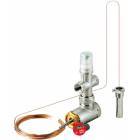The design specifications of shut-off valves
To allow the careful protection and control of the structures, shut-off valves must be designed according to the structural characteristics provided for by the I.S.P.E.S.L. (Italian Institute for Occupational Safety and Prevention)

Shut-off valves are devices that assess the amount of fuel reaching the heat generator, in order to better manage the temperature of the heat transfer fluid and ensure the best performance of the hydraulic heating system. The device works in close contact with the fuel and therefore it is subject to inspection by the I.S.P.E.S.L. and must comply with certain specifications.
In order to put on the market the range of shut-off valves, it is very important that such inspection and specifications are complied with. I.S.P.E.S.L specifications outline that shut-off valves must contain the following components manufactured according to the specifications provided for by the same entities: the body of the shut-off valve and its control must be made from CW617N brass and subsequently forged and chrome plated. The bellows must be made from phosphor bronze and the length of the copper probe must be 5 metres. The control rod of the shut-off valve must be made from stainless steel, whereas the o-rings must be made from nitrile rubber. Furthermore, all the springs cannot be made from any other metal alloy than steel, whilst any other parts must be made from CW617 brass.
These are just some of the requirements laid down by the various entities that regulate whether shut-off valves suitably comply with the design standards and therefore can be put on the market.
In order to put on the market the range of shut-off valves, it is very important that such inspection and specifications are complied with. I.S.P.E.S.L specifications outline that shut-off valves must contain the following components manufactured according to the specifications provided for by the same entities: the body of the shut-off valve and its control must be made from CW617N brass and subsequently forged and chrome plated. The bellows must be made from phosphor bronze and the length of the copper probe must be 5 metres. The control rod of the shut-off valve must be made from stainless steel, whereas the o-rings must be made from nitrile rubber. Furthermore, all the springs cannot be made from any other metal alloy than steel, whilst any other parts must be made from CW617 brass.
These are just some of the requirements laid down by the various entities that regulate whether shut-off valves suitably comply with the design standards and therefore can be put on the market.
12/03/2014
I contenuti di questo sito non hanno carattere di periodicità e non rappresentano 'prodotto editoriale'.








